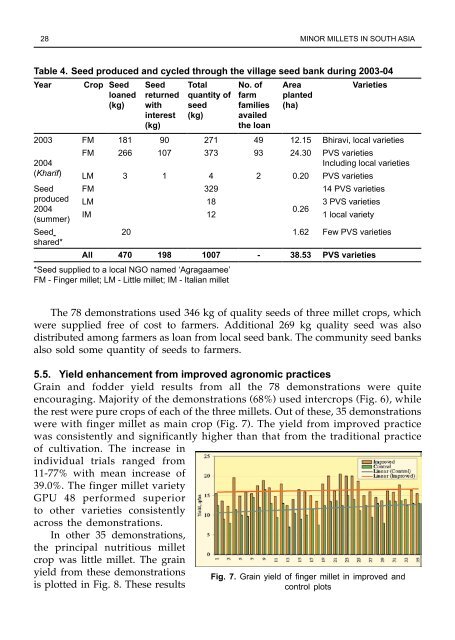Minor millets in South Asia: learnings from IFAD-NUS project in India ...
Minor millets in South Asia: learnings from IFAD-NUS project in India ...
Minor millets in South Asia: learnings from IFAD-NUS project in India ...
Create successful ePaper yourself
Turn your PDF publications into a flip-book with our unique Google optimized e-Paper software.
28 m<strong>in</strong>or <strong>millets</strong> <strong>in</strong> south asia<br />
Table 4. Seed produced and cycled through the village seed bank dur<strong>in</strong>g 2003-04<br />
Year Crop Seed Seed Total No. of Area<br />
Varieties<br />
loaned returned quantity of farm planted<br />
(kg) with seed families (ha)<br />
<strong>in</strong>terest (kg) availed<br />
(kg)<br />
the loan<br />
2003 Fm 181 90 271 49 12.15 Bhiravi, local varieties<br />
2004<br />
(Kharif)<br />
seed<br />
produced<br />
2004<br />
(summer)<br />
seed<br />
shared*<br />
Fm 266 107 373 93 24.30 pVs varieties<br />
<strong>in</strong>clud<strong>in</strong>g local varieties<br />
lm 3 1 4 2 0.20 pVs varieties<br />
Fm 329<br />
14 pVs varieties<br />
lm<br />
im<br />
18<br />
12<br />
0.26<br />
3 pVs varieties<br />
1 local variety<br />
The 78 demonstrations used 346 kg of quality seeds of three millet crops, which<br />
were supplied free of cost to farmers. Additional 269 kg quality seed was also<br />
distributed among farmers as loan <strong>from</strong> local seed bank. The community seed banks<br />
also sold some quantity of seeds to farmers.<br />
5.5. Yield enhancement <strong>from</strong> improved agronomic practices<br />
Gra<strong>in</strong> and fodder yield results <strong>from</strong> all the 78 demonstrations were quite<br />
encourag<strong>in</strong>g. Majority of the demonstrations (68%) used <strong>in</strong>tercrops (Fig. 6), while<br />
the rest were pure crops of each of the three <strong>millets</strong>. Out of these, 35 demonstrations<br />
were with f<strong>in</strong>ger millet as ma<strong>in</strong> crop (Fig. 7). The yield <strong>from</strong> improved practice<br />
was consistently and significantly higher than that <strong>from</strong> the traditional practice<br />
of cultivation. The <strong>in</strong>crease <strong>in</strong><br />
<strong>in</strong>dividual trials ranged <strong>from</strong><br />
11-77% with mean <strong>in</strong>crease of<br />
39.0%. The f<strong>in</strong>ger millet variety<br />
GPU 48 performed superior<br />
to other varieties consistently<br />
across the demonstrations.<br />
In other 35 demonstrations,<br />
the pr<strong>in</strong>cipal nutritious millet<br />
crop was little millet. The gra<strong>in</strong><br />
yield <strong>from</strong> these demonstrations<br />
is plotted <strong>in</strong> Fig. 8. These results<br />
20 1.62 Few pVs varieties<br />
All 470 198 1007 - 38.53 PVS varieties<br />
*seed supplied to a local ngo named ‘agragaamee’<br />
Fm - F<strong>in</strong>ger millet; lm - little millet; im - italian millet<br />
Fig. 7. Gra<strong>in</strong> yield of f<strong>in</strong>ger millet <strong>in</strong> improved and<br />
control plots

















